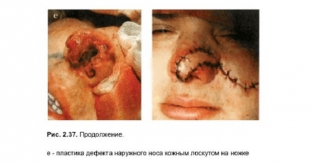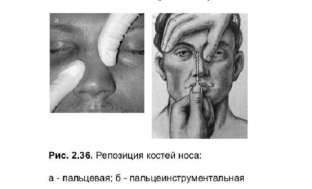Nose trauma is one of the most common reasons for patients to visit a trauma center. It is quite easy to injure the nose, since this area of the face is the most prominent and is very susceptible to traumatic factors. In everyday life, a person of absolutely any age can damage the nose through the influence of completely different factors. Depending on the cause and nature of the damage, the doctor chooses a method for treating nasal injuries. It can be both a fairly simple one-stage procedure, and a complex plastic surgery. What treatment tactics should be chosen for the treatment of nasal injuries?
Method of treatment of nasal injuries not accompanied by bone fractures
Soft tissue injuries, abrasions and bruises are the most harmless injuries of the nose. Such traumatization occurs, as a rule, in everyday life, under the influence of various traumatic agents, while the bones of the face are not damaged. For the treatment of nasal injuries of this nature, fairly simple conservative methods of therapy are used. In the first few hours after the injury, it is recommended to apply ice to the nose area in order to reduce soft tissue swelling. In the presence of nosebleeds, it is most often stopped by anterior loop, and in more complex cases, posterior nasal tamponade. A suture on wounds in which damage to the skin occurs is applied on the first day after injury with preliminary primary surgical treatment of the wound.

Methods of treatment of fractures of the bones of the nose
In more severe injuries of the nose, a fracture of the bones of the nose is observed, which may be with or without displacement of bone fragments. The method of treatment of nasal injuries of this nature is the reposition of the bones of the nose with fixation of bone fragments. It is recommended to conduct it on the first day after injury. The main types of reposition are as follows:
- finger reposition – performed with a lateral displacement of the external nose by pressing the thumb on the nose in the direction necessary in each individual case;
- The use of nasal elevators is recommended in cases where depressed fractures of the nasal bones are observed. Special nasal elevators are inserted into the nasal cavity and by traction anteriorly or upward, the normal position of the nose is restored;
- Finger-instrumental reduction implies the simultaneous use of the spirit of the above methods and is recommended in case of simultaneous displacement of bone fragments to the side and posteriorly.
After restoring the normal position of the nose, the bone fragments are fixed with nasal tamponade.

Rhinoseptoplasty - a method of treating serious injuries of the nose
In case of nasal injuries, which are accompanied by more serious defects, persistent deformities and are often combined with nasal septal curvature and nasal breathing disorders, it is necessary to carry out cosmetic, aesthetic and plastic correction of the nasal injury. For this purpose, in most cases, performs such an operation as rhinoseptoplasty – simultaneous correction of the position of the structures of the nose and the elimination of cosmetic defects. Rhinoseptoplasty is performed by operating otorhinolaryngologists and plastic surgeons, who must have sufficient experience in performing such a complex surgical intervention.
Methods of treatment of paranasal sinus injuries
Traumatic injuries of the maxillary and frontal paranasal sinuses are most often observed.
- Fractures of the walls of the maxillary sinus in most cases are accompanied by depression of bone fragments, fractures of the zygomatic bone and the wall of the orbit, as well as hemorrhage into the sinus cavity. For the treatment of such injuries, surgical interventions are used to eliminate a cosmetic defect, remove blood from the sinus and restore normal outflow from it. Often necessary is the imposition of an anastomosis with the nasal cavity under the inferior turbinate.
- Fractures of the walls of the frontal sinus are often accompanied by dysfunction of the canal, due to the depression of the bone fragment into the sinus. In such cases, the reposition of the anterior wall of the sinus, the formation of the fronto-nasal anastomosis and the installation of drainage are performed. In the presence of nasal liquorrhea, it is necessary to consult a neurosurgeon.







Add a comment